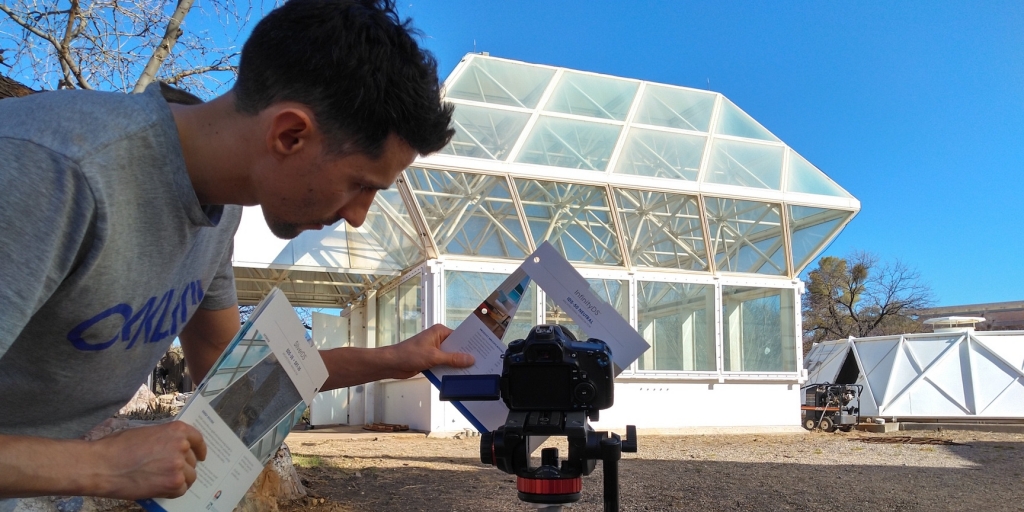
The 1987 Test Module (prototype for the Biosphere 2) will be the controlled environment / greenhouse for SAM. Many simultaneous plant studies will be conducted in the Test Module, including the growth of food cultivars to offset groceries introduced at SAM, mushrooms as a means to convert inedible biomass into digestible nutrients, and algae as a carbon dioxide (CO2) sequestration agent in addition to the variety of plants contained therein.
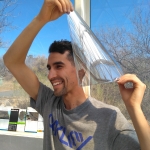 We recognize that a greenhouse such as the Test Module is not a structure that will be built on Mars, at least not in its current form. There are four reasons for this: a) radiation that the Martian atmosphere is too thin to mitigate and that glass does not reject; b) ability to manage the high pressure differential between the interior and exterior; c) ability to manage the extreme temperature differentials; and d) low ambient light for plant growth, just 590 watts per square meter on Mars compared to 1000 watts per square meter on Earth, both measured at zenith. Nearly all food cultivars will require additional, synthetic lighting even if routinely exposed to full sunlight on Mars.
We recognize that a greenhouse such as the Test Module is not a structure that will be built on Mars, at least not in its current form. There are four reasons for this: a) radiation that the Martian atmosphere is too thin to mitigate and that glass does not reject; b) ability to manage the high pressure differential between the interior and exterior; c) ability to manage the extreme temperature differentials; and d) low ambient light for plant growth, just 590 watts per square meter on Mars compared to 1000 watts per square meter on Earth, both measured at zenith. Nearly all food cultivars will require additional, synthetic lighting even if routinely exposed to full sunlight on Mars.
Therefore, we are modifying the Test Module to more closely represent a greenhouse structure on Mars, if one were to be built above ground. All surfaces facing up (the greatest exposure to radiation through the least amount of Martian atmosphere) will be painted with a reflective, white elastimeric to represent radiation shielding or regolith. The vertical glass panes (base level of the TM) will be tinted darker to reduce the ambient optical transmission by approximately 50% to match the 590/1000 watts per square meter reduction from Earth to Mars. What’s more, each film rejects between 75-85% infrared light, drastically reducing the thermal load on the total structure and thereby reducing power consumption by the mini-split air conditioners.
We used a Canon 60D camera with Tokina 12-24mm zoom lens set to a fixed ISO 250 and shutter speed 1250. We then held each of eight window films to the front of the lens and took a photo with no adjustments made. After the photo, we adjusted the f-stop ring to move the light meter back to its center, zero calibration. The difference between the two indicates the amount of light reduced, from the point of view of the camera sensor behind the film.
These are the results of our study.
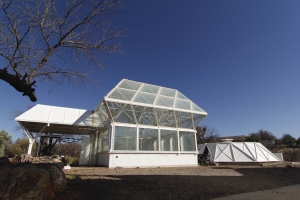
- Baseline, no window film applied
- Canon 60D, ISO 250
- Shutterspeed 1250
- Photo at f-stop 8 for a neutral lighting
- Visible Light Transmission: 100% (not including the glass itself)
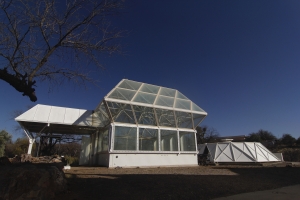
- Window film: 1DS-50 Neutral
- Canon 60D, ISO 250
- Shutterspeed 1250
- Photo at f-stop 8, adjusted to neutral at f-stop 6.5
- Visible Light Transmission: 60% with glass
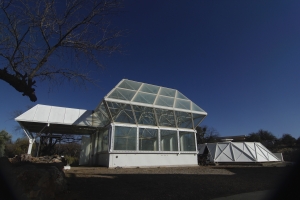
- Window film: Therm-X 50
- Canon 60D, ISO 250
- Shutterspeed 1250
- Photo at f-stop 8, adjusted to neutral at f-stop 6.5
- Visible Light Transmission: 47% with glass (see discussion below)
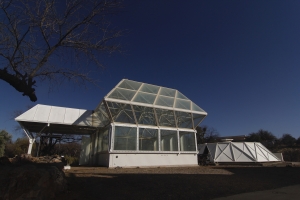
- Window film: SYDS-50 Dual Reflective
- Canon 60D, ISO 250
- Shutterspeed 1250
- Photo at f-stop 8, adjusted to neutral at f-stop 5.6
- Visible Light Transmission: 47% with glass
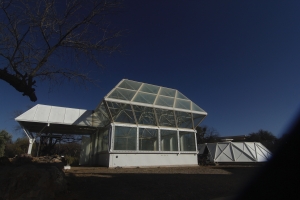
- Window film: Ceramic 45
- Canon 60D, ISO 250
- Shutterspeed 1250
- Photo at f-stop 8, adjusted to neutral at f-stop 5.6
- Visible Light Transmission: 42% with glass
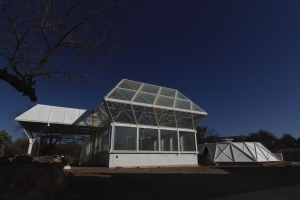
- Window film: SYDS-35 Duel Reflective
- Canon 60D, ISO 250
- Shutterspeed 1250
- Photo at f-stop 8, adjusted to neutral at f-stop 5.0
- Visible Light Transmission: 40% with glass
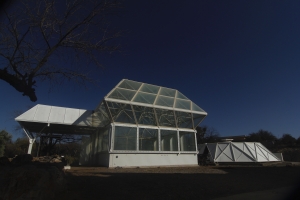
- Window film: Ceramic 35
- Canon 60D, ISO 250
- Shutterspeed 1250
- Photo at f-stop 8, adjusted to neutral at f-stop 5.0
- Visible Light Transmission: 31% with glass
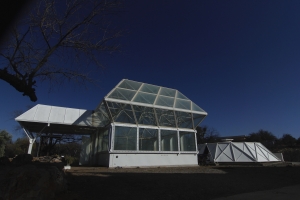
- Window film: Therm-X 30
- Canon 60D, ISO 250
- Shutterspeed 1250
- Photo at f-stop 8, adjusted to neutral at f-stop 5.0
- Visible Light Transmission: 27% with glass
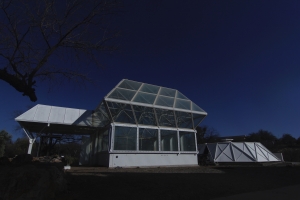
- Window film: SDS-35 / SXT-35
- Canon 60D, ISO 250
- Shutterspeed 1250
- Photo at f-stop 8, adjusted to neutral at f-stop 4.5
- Visible Light Transmission: 26% with glass
The aperture of a camera lens is measured by the f-stop value, a ratio of the focal length of the lens (entry point of light to the exit) divided by the diameter of the aperture, or the opening created by concentric sheets of thin metal that converge around the center. The larger the opening the more light that enters, thus the shorter depth of field; the smaller the opening the less light that enters, thus requiring a longer exposure and greater depth of field.
A good explanation is given by the website Expert Photography.
The full f-stop values are as follows: f/1.4, f/2, f/2.8, f/4, f/5.6, f/8, f/11, f/16, f/22, …
Where f/1.4 is the largest and f/64 is the smallest opening, each increase in value in the denominator represents a 50% reduction in light. From f/1.4 to f/2 is a 50% reduction, again from f/2 to f/2.8, and so forth. For those inclined to take the mathematics a bit further, use the formula for the area of a circle (pi * radius squared) to approximate how these values relate to the opening of the aperture.
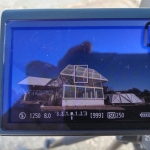 Now, we will determine which level of visible light transmission (VLT) is a good approximation to that of the average, ambient sunlight on Mars. We started with an f-stop setting of f/8. The first window film 1DS-50 Neutral invoked an f-stop of f/6.5 to bring the light meter back to 0. This is a half stop, or roughly 25% reduction in VLT. The Therm-X 50 seems to be incorrectly rated or the camera did not register properly, as its 47% VLT does not match the 75% transmission seen by the camera.
Now, we will determine which level of visible light transmission (VLT) is a good approximation to that of the average, ambient sunlight on Mars. We started with an f-stop setting of f/8. The first window film 1DS-50 Neutral invoked an f-stop of f/6.5 to bring the light meter back to 0. This is a half stop, or roughly 25% reduction in VLT. The Therm-X 50 seems to be incorrectly rated or the camera did not register properly, as its 47% VLT does not match the 75% transmission seen by the camera.
The SYDS-50 Dual Reflective and Ceramic 45 both invoke a full stop, from f/8.0 to f/5.6 which is a 50% reduction in VLT and closely matches the stated 47% and 42% VLT per the product specs. If we had a more finely graduated light meter than the one built-in to the camera, we might see values closer to the window film specs.
With the remaining window films the f-stop value moves to f/5.0 (another half stop) and f/4.5 for the darkest (two full stops from the original, unfiltered f/8.0) for a 75% reduction in light which perfectly matches the window film manufacturer specs of 26% VLT.
Furthermore, we will choose a non-reflective film such that visiting researchers to SAM will not feel boxed into the Test Module at night where interior lights would reflect back. While the windows will be darker, we do want for our analog astronauts to enjoy the Moon, planets, and stars overhead to retain a sense of the vast cosmos despite their relative isolation in the sealed SAM habitat.
It appears the Ceramic 45 window film will give us the closest approximation to the visible sunlight on Mars.
“We thank Greg Spencer, owner of AGTP Window Films from Tucson, Arizona for provision of the window film packet used in this comparative study. We discovered Greg through a local search and subsequently learned that his company was on-site at Biosphere 2 in 1991 having applied films to the Biosphere apartment windows and campus facilities. With more than 40 years experience, we are not surprised that most of those applications are yet in place and holding!
Greg has generously donated his time and materials for this unique project. We welcome the return of Greg the Tinter to Biosphere 2, and are eager for his high quality product to be installed at SAM. Thank you!” –Kai Staats, Director of SAM

